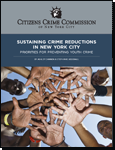
|
|
E-Responder Evaluation: Cultivating Resilience and Sociopolitical Empowerment (2017)
E-Responder was developed by the Crime Commission in partnership with NYU and NYC Cure Violence to intervene with youth in new, virtual spaces of conflict. This third and final evaluation demonstrates that E-Responder had significant effects on two critical outcomes, both of which are predicted to facilitate positive long-term results for youth: (1) resilience, by building on youths' existing strengths, coping skills and empowering them to face adversity and grief; and (2) sociopolitical awareness, by providing youth with the vocabulary and opportunity to discuss topics such as inequality, oppression, privilege and race. The findings from the three research briefs demonstrate the effectiveness of E-Responder as an intervention engaging youth online, where they are highly involved and literate and moreover, that E-Responder is more than an intervention model; it is an early-prevention strategy.
» read the report
|

|
|
E-Responder Poster: Interruptions of Risky Online Behavior De-escalate Violent Conflict (2017)
E-Responder was presented at the Society for Community Research and Action (SCRA) 2017 Biennial Conference "Transformative Community Psychology" in Canada to discuss the innovative approach of conducting intervention through social media, research study, and results.
» read the poster
|

|
|
Social Media as an Opportunity for Service (2017)
The high visibility of harmful behavior, trauma, grief, and emotional distress on social media gives service providers the opportunity to know exactly who is at the highest risk for committing or being victimized by violence and in greatest need of service. We need to capitalize on this opportunity by giving anti-violence professionals a new method of responding to risky social media use. As modes of communication have changed to favor online spaces, so too must our interventions.
» read the report
|

|
|
Sustaining Crime Reductions in New York City: Priorities for Preventing Youth Crime (2015)
New York City's success at driving crime down to unprecedented lows has ushered in a new era of policing: one in which more time is spent preventing crimes than reacting to them. In this report, the Crime Commission recommends that to sustain these crime reductions, the police and the growing body of responsible stakeholders should prioritize efforts that address youth victimization and exposure to violence; develop the youth workforce; enhance legitimacy; break down silos to improve coordination; and address the negative impacts that state and local policies have on youth.
» read the report
|

|
|
Police and Public Safety in New York City (2004)
This study of police operations, crime and public safety in New York discusses recent trends in law enforcement including the increased importance of counter-terrorism police work in the post-Sept. 11 environment. It also includes the results of surveying work regarding public perceptions about neighborhood safety, police and police-community relations, and quality of life enforcement. These findings are presented both at the citywide level and also broken down by borough and ethnicity.
» read the report
|

|
|
Crime, Police and the Community (2001)
This report looked at public attitudes towards the police, especially in terms of how the public felt about significant crime reductions that had occurred during the 1990s. It also includes the Commission's analysis of recent trends and its recommendations for further improvements. The appendix contains information about the report's methodology and survey team.
» read the report
|

|
|
Restoring a Safe New York (1990)
This report, released at a time when crime in New York City had reached
alarmingly high levels, warned that unchecked criminal activity posed a
significant threat and made several recommendations to address the
problem. The Commission advised the city to adopt crime-fighting
strategies based on the "broken windows" theory of policing, which
called for law enforcement to move away from reactive 911-based policing
towards a more proactive crime prevention and maintenance of order
approach. It also advised adding 5,000 police officers to the force and
the creation of community courts. In the mid-1990s these recommendations
began to show significant results, leading to New York City's historic
recent reduction in crime and a dramatic improvement in the quality of
life in the community.
» read the report
|




